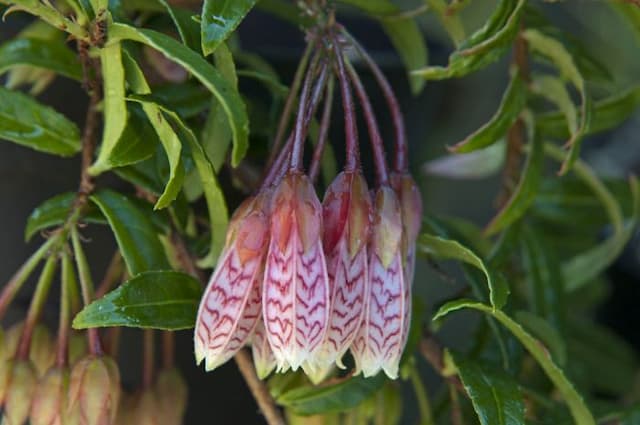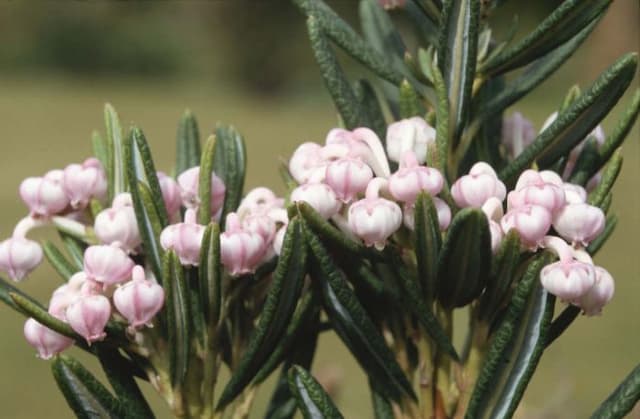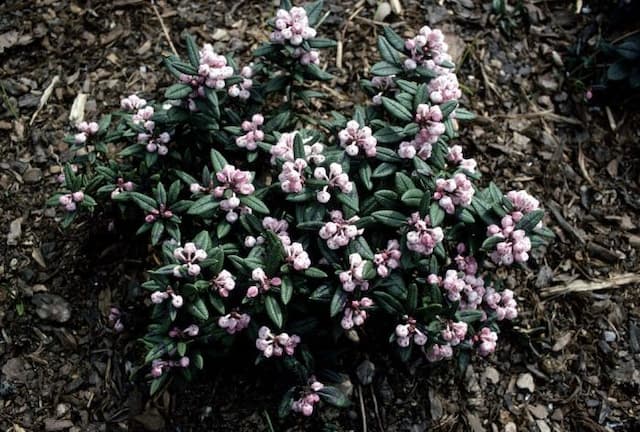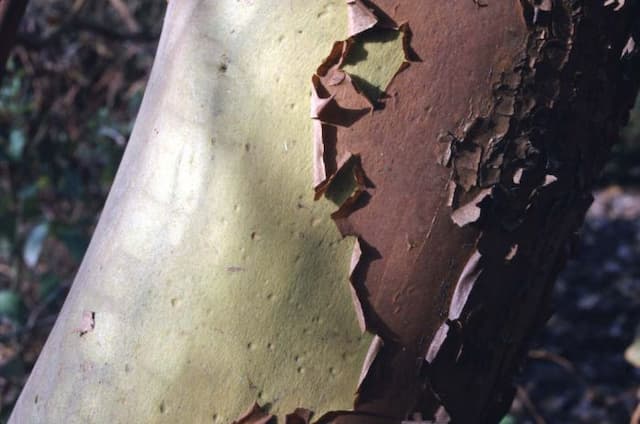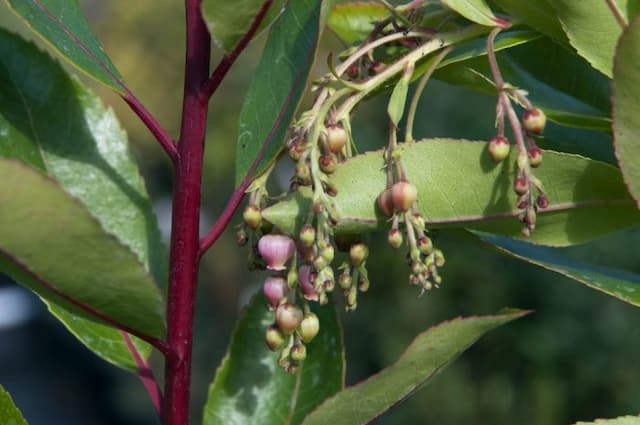Royal azalea Rhododendron schlippenbachii (A)

ABOUT
Rhododendron schlippenbachii, commonly known as the royal azalea, is a deciduous shrub that is prized for its attractive flowers and foliage. Its appearance is marked by a spectacular display of blooms that come in shades of pink, often with a paler center and darker spots. These flowers are trumpet-shaped and grow in clusters at the tips of the branches. The leaves of the royal azalea are equally beautiful, emerging in spring with a light green or reddish-bronze color. As they mature, they turn into a rich green, offering a striking contrast to the flowers. In autumn, the foliage changes again, providing a final show of color ranging from yellow to red before the leaves drop for the winter. The bark of the royal azalea has a smooth texture and can have a reddish-brown to gray hue. This adds to the overall aesthetic of the shrub throughout the year, even when the plant is not in bloom or has shed its leaves. In general, the royal azalea has a rounded shape with multiple stems and a pleasing, symmetrical form. The branches grow in a somewhat open fashion, giving the shrub an airy feel. This combination of ornate flowers, attractive foliage throughout the seasons, and appealing shape makes the royal azalea a favored choice for gardens and landscapes.
About this plant
 Names
NamesFamily
Ericaceae.
Synonyms
Royal Azalea, King's Rhododendron, Schlippenbach's Rhododendron.
Common names
Azalea schlippenbachii, Rhododendron fauriei, Rhododendron mastersianum.
 Toxicity
ToxicityTo humans
Royal azalea (Rhododendron schlippenbachii) is known to be toxic to humans if any part of the plant is ingested. All parts of the plant contain andromedotoxins and grayanotoxins, which can cause poisoning. Symptoms can include vomiting, diarrhea, hypersalivation, weakness, hypotension (low blood pressure), bradycardia (slowed heart rate), and cardiac arrhythmias. In severe cases, ingesting royal azalea may result in coma or death.
To pets
Royal azalea (Rhododendron schlippenbachii) is also toxic to pets, including cats and dogs. Similar to the toxicity in humans, ingesting any part of the royal azalea plant can cause pet poisoning due to the presence of andromedotoxins and grayanotoxins. Symptoms in pets may include vomiting, diarrhea, drooling, loss of appetite, weakness, lethargy, walking as if drunk (ataxia), seizures, and potentially, coma. In severe cases, cardiac failure and death can occur. It is crucial to prevent pets from having access to this plant.
 Characteristics
CharacteristicsLife cycle
Perennials
Foliage type
Deciduous
Color of leaves
Green
Flower color
Pink
Height
4-6 feet (1.2-1.8 meters)
Spread
4-8 feet (1.2-2.4 meters)
Plant type
Shrub
Hardiness zones
5
Native area
Korea
Benefits
 General Benefits
General Benefits- Landscape Aesthetics: Rhododendron schlippenbachii, commonly known as the Royal Azalea, is widely appreciated for its beautiful pink to white flowers that enhance the visual appeal of gardens and landscapes.
- Habitat Support: The Royal Azalea provides nectar and pollen for pollinators such as bees and butterflies, supporting local ecosystems.
- Shade Tolerance: Capable of growing in partial shade, the Royal Azalea is suitable for underplanting in woodland gardens or shaded areas.
- Seasonal Interest: With its spring blooms and often vibrant fall foliage colors, it offers multiple seasons of interest in the garden.
- Erosion Control: The shrub's root system can help stabilize soil on slopes, preventing erosion.
- Diversity Contribution: As a part of a mixed shrub border, the Royal Azalea adds species variety that can enhance biodiversity in landscaped areas.
- Cultural significance: In some areas, it is cherished for its cultural and symbolic value, particularly in Korea where it is the provincial flower of South Gyeongsang Province.
 Medical Properties
Medical Properties- This plant is not used for medical purposes.
 Air-purifying Qualities
Air-purifying QualitiesThis plant is not specifically known for air purifying qualities.
 Other Uses
Other Uses- As a source of nectar and pollen for bees, Rhododendron schlippenbachii, or the royal azalea, is valuable for supporting local bee populations and contributing to the production of honey with a unique floral note.
- The royal azalea is used in landscaping and ornamental gardening for its striking spring blooms, adding aesthetic value to parks, gardens, and naturalized areas.
- Dried royal azalea petals can be used to create natural dyes for fabrics, imparting a range of delicate pink to purple hues depending on the mordant used.
- Royal azalea wood, being fine-grained and dense, is sometimes used for crafting small wooden objects such as handles, inlaid work, or specialized carpentry requiring detail.
- This plant is incorporated into educational activities, where students learn about plant biology and the importance of preserving native species through hands-on cultivation and growth observation.
- Pressed royal azalea flowers are used in art projects and crafts, such as creating bookmarks, cards, or decorative pieces, due to their color and shape.
- In photography, the striking appearance of the royal azalea in bloom serves as a popular subject for nature photographers, enhancing portfolio diversity with images of its vivid flowers.
- During festivals and celebrations in regions where it is native, branches of the royal azalea may be used as natural decorations or in parades to symbolize the arrival of spring.
- The royal azalea can sometimes be used as a natural barrier plant in gardens, its dense foliage providing a visual screen and its shallow root system reducing interference with other plants.
- Culinary enthusiasts sometimes use the petals of the royal azalea to garnish desserts or salads, although caution is advised as some parts of rhododendrons can be toxic if not prepared correctly.
Interesting Facts
 Feng Shui
Feng ShuiThe Royal Azalea is not used in Feng Shui practice.
 Zodiac Sign Compitability
Zodiac Sign CompitabilityThe Royal Azalea is not used in astrology practice.
 Plant Symbolism
Plant Symbolism- Beware or Caution: In many regions, the Rhododendron, also known as the Royal Azalea, is considered a symbol of caution due to the fact that the plant is toxic if ingested. This symbolism is a reminder to be cautious about what may seem beautiful but can be harmful.
- Rejuvenation: The Royal Azalea's vibrant blooms are associated with the idea of renewal and rebirth, often aligning with the spring season when these plants flower profusely, representing new beginnings and a fresh start.
- Homecoming: In some cultures, the blossoming of the Royal Azalea signifies a time to return home or the welcoming of others into one's home, embodying hospitality and the bond of family or community.
 Water
WaterRoyal azalea requires consistently moist soil, particularly during the growing season, but it's important to avoid waterlogging. It should be watered thoroughly whenever the top inch of soil feels dry to the touch. Depending on the weather and soil conditions, this might be about once a week. Use about 1 to 1.5 gallons of water per watering session for a medium-sized plant to ensure deep soil moisture. In hot, dry periods, increase watering frequency but be cautious of overwatering as this can lead to root rot.
 Light
LightRoyal azalea thrives in light conditions ranging from partial shade to filtered sunlight. Direct afternoon sun can be harmful, causing leaf scorch, while deep shade can reduce flowering. The best spot for this plant is in an area that receives morning sunlight and is protected from the intense sun in the afternoon.
 Temperature
TemperatureRoyal azalea prefers moderate temperatures and is hardy in zones 5-7. It can tolerate minimum winter temperatures down to -20°F and maximum summer temperatures of up to 80°F. However, the ideal temperature range for promoting the best growth and flowering is between 50-75°F.
 Pruning
PruningRoyal azalea benefits from light pruning to shape the plant, remove dead flowers, and promote bushier growth. The best time for pruning is immediately after the blooming period, as next year's buds form in summer. Pruning should be done annually for maintaining a compact shape and to encourage more vigorous blooms for the following year.
 Cleaning
CleaningAs needed
 Soil
SoilRoyal azaleas prefer acidic soil with a pH of 4.5 to 6.0. A mix of 50% peat, 30% pine bark, and 20% perlite creates an ideal structure for drainage and aeration. Keep the soil evenly moist without waterlogging.
 Repotting
RepottingRoyal azaleas should be repotted every 2-3 years, ideally in spring before new growth begins. Ensure a gentle repotting process to avoid root damage.
 Humidity & Misting
Humidity & MistingRoyal azaleas thrive in high humidity levels, ideally between 60-80%. They benefit from a moist environment but should not be subjected to soggy conditions.
 Suitable locations
Suitable locationsIndoor
Bright, indirect light; high humidity; cool temps; acidic soil.
Outdoor
Part shade to full sun; shelter from wind; well-draining acidic soil.
Hardiness zone
5-8 USDA
 Life cycle
Life cycleRoyal azalea (Rhododendron schlippenbachii) begins its life cycle as a seed, which, when conditions are favorable, germinates and develops into a seedling. The seedling grows through photosynthesis and nutrient uptake, eventually maturing into an adult plant that features characteristic large, showy, pink flowers in spring. After pollination, often by insects attracted to its blooms, the fertilized flowers develop into seed pods. As the growing season progresses, these seed pods mature, and by late summer or autumn, they dry and split open to release their seeds. The cycle is then ready to begin anew with seed dispersal, which can be facilitated by wind or wildlife. Throughout its life, the royal azalea experiences periods of growth, flowering, and dormancy, typically marked by leaf fall in winter, in regions where the plant is deciduous.
 Propogation
PropogationPropogation time
Spring
The Royal Azalea (Rhododendron schlippenbachii) is commonly propagated through semi-hardwood cuttings. This method involves taking cuttings from the current year's growth in late summer, typically from July to September. The stems should be partially matured but not fully hardened, usually 4 to 6 inches in length. These cuttings should be taken with a sharp, clean cutting tool to prevent damage and disease. The lower leaves are removed, and the cut end is dipped in a rooting hormone to encourage root development. The cuttings are then placed in a well-draining rooting medium such as a mix of peat and perlite. The pots should be kept in a warm, humid environment, out of direct sunlight, to ensure the best chance for rooting. Proper care includes maintaining consistent moisture levels and providing gentle warmth until roots have developed, usually within a few weeks.
